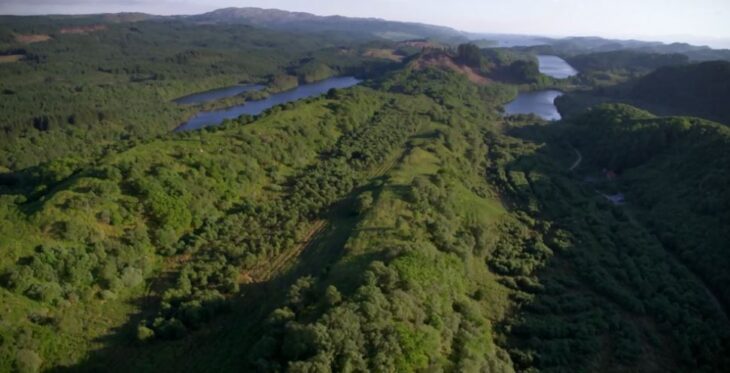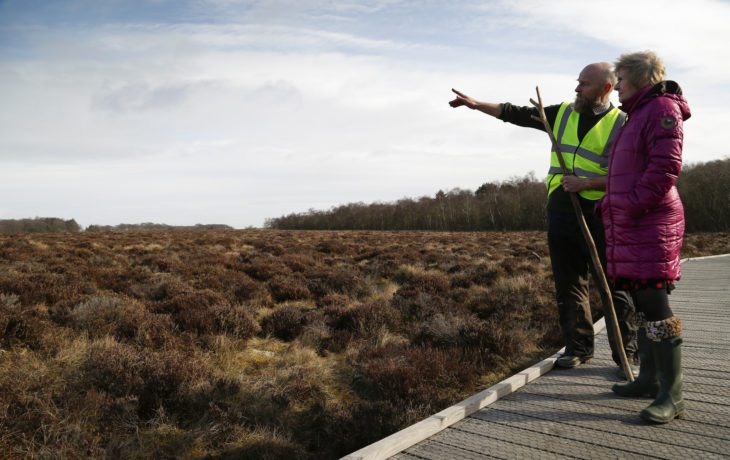Natural solutions are essential to meeting net-zero emissions

Ecological and climate breakdown are inextricably linked – they reinforce and co-develop together in complex ways. Overall, as one worsens, so does the other. That complicates the crisis, but it can also give us hope and a framework for action.
The Scottish Government, following the report by the Committee on Climate Change (CCC), is committing to achieving net-zero emissions by 2045, at the Committee’s recommendation. The UK overall is aiming to achieve net-zero by 2050, which also follows calls to do so across Europe.
Why 2045, and why now?
Whilst some evidence suggests that 2045 is still too late to guarantee warming is kept below 1.5 degrees, and possibly even 2 degrees, the Scottish Government’s new target is progress, and it’s more than most have committed to. The CCC has been careful to point out that whilst the target is ambitious, it makes no assumptions about future technology or radical interventions, and it balances this ambition with the possibility of policy failure. What that means is Scotland’s 2045 target is achievable using the technology we have now, and resilient to possible policy setbacks.
Why the difference between UK and Scotland? That comes down to how we define ‘net-zero’. The amount of greenhouse gases in the atmosphere, like carbon dioxide and methane, is best understood as a system in flux – we contribute greenhouse gases, but there are also processes that pull a small portion of them out of the atmosphere. And there are other ecosystems, like peatlands, that store away incredible quantities of carbon and methane, preventing it getting to the atmosphere in the first place. ‘Net-zero’ means some residual emissions can remain from our activities, as long as the ability to absorb these isn’t exceeded – it’s about the balance between carbon emissions and carbon sinks.
Scotland is better positioned than the rest of the UK to maximise these natural solutions: the ability of ecosystems to cumulatively help regulate the climate.
How do we do it?
Agriculture is a great example of how we can do that. The way we produce food sustains us, but we can’t sustain it. However, ecological principles can be inserted into how we manage land, or ‘agroecology’, to restore balance. At present, the UN has warned our soils have fewer than 60 harvests remaining, and our pesticide use directly contributes to what scientists already call the sixth mass extinction – because as insects decline in vast quantities, so too does the rest of the food web. As our soils are depleted, their ability to store carbon is reduced. Scotland’s soils contain the equivalent of centuries’ worth of our annual emissions. Agroecology begins with these complex connections and looks for ways to rebalance them. Around the world, it often means dispensing with techniques that were developed during colonial times, and remembering age-old connections to the land.
The Chief Executive of Scottish Natural Heritage reinforced this in her speech to the Royal Society of Edinburgh, “For farming and forestry we need to think carefully and constructively about the transformations needed in how we use the land to simultaneously reduce emissions, protect and enhance nature, and help build resilience against the inevitable impacts of a changing climate.”

The IUCN has been speaking about natural solutions for a while. As they put it, “Natural ecosystems regulate river systems, protect crop wild relatives, filter water, store carbon, buffer shorelines, build wild fish stocks and give shelter to vulnerable human communities”. IUCN point out how natural solutions are already playing a large role in helping to the meet the Sustainable Development Goals in protected areas. But to achieve net-zero, and re-write our contract with nature, we need to go far beyond protected areas and integrate natural solutions in agriculture, in city planning, in woodland generation, and so on.
Time is not on our side, and the more we delay, the more drastic our actions will need to be. The IPCC says we have just 11 years to tackle climate breakdown, and we don’t know for sure what role feedback loops will play in the future – in short, we can’t be sure that we haven’t already entered a period of runaway climate change. The difference between 1.5, 2, and 3+ degrees doesn’t sound like much, but the differences are literally life and death.
Systemic change, therefore, is inevitable. The onus must be on designing that change now, rather than reacting to it. As the CCC report makes clear, to achieve net-zero emissions means individual and systemic changes.
So, let’s be clear about what a 2045 target means: it means we need to take action now, not at some point in the future. That includes phasing out our reliance on fossil fuels and building a just transition to replace it. It also means mobilising our resources to prioritise ecosystem restoration.
The Trust will work to ensure a series of natural solutions are part of our national response to climate and ecological breakdown:
- Peatland restoration – Peatlands have helped regulate the climate since at least the early Holocene. Already a world-leader, Scotland’s peatlands contain the equivalent of 140 years’ worth of our carbon emissions. When peatlands are degraded, this carbon leaks out – and in some places in Scotland, we’re destroying ancient peatlands that take thousands of years to develop.
- Woodland regeneration – Trees and other vegetation that make up diverse woodlands store carbon. Scotland’s woodlands are still recovering from their low of just 4% of land cover in the 20th century. The government target is 21%, while the CCC report says 30% is necessary. This is still below the European average, even in countries with higher population densities. Together with a range of partners, we’ve written to the First Minister to outline how woodlands can play an important role in the climate and ecological crises, while making sure afforestation is responsible.
- Land stewardship – Working with, rather than against, natural processes, we need to steward the land by recognising that we inhabit it for brief moments before passing it to future generations, and that we share it with species whose livelihoods we depend on.
- Agroecology – We need to minimise and phase out chemical inputs into our soils, while integrating other land uses, like forestry, into how we produce food. This can also help build more resilient systems against severe weather, like drought.
- Protected areas – Havens for biodiversity, our protected areas form essential networks at local, national, and global scales. They are more than the sum of their parts. Yet they are threatened by irresponsible development and impacts from elsewhere. Some studies have shown that insects are in greater decline in protected areas than non-protected areas, as pollution accrues to the area from elsewhere – protecting these areas often means looking outwith them.
- Ecosystem restoration – We’re only now starting to work out the complex ways that specific species and wider ecosystems play a role in carbon cycles. As one large review study recently concluded, “Wild animal species are rarely considered as part of the solution”, the authors detail “a pathway forward for deciding when and how conserving or managing a diversity of animal species could in fact enhance ecosystem carbon uptake and storage”. “Such understanding informs international climate and biodiversity initiatives.”
- The urban ecology – Across the world, we increasingly live in urban environments. For a long time, we’ve viewed the city as a boundary between us and nature – a physical line that reinforces the cognitive distance between modern lives and the living planet. Not only is this farcical, but there’s growing evidence it impacts our health and wellbeing. Some of the most innovative climate and biodiversity work is happening in cities – whether its attracting pollinators, growing vertical forestry, or targeting air pollution with tree planting. Scotland’s cities are already looking for ways to ‘green’ the urban landscape, for people and wildlife.
For many of these, we need to continue developing our knowledge and building data, for instance on soils to determine where and how we can increase their carbon content – which has additional benefits like holding water for longer, helping to prevent flooding and increase resilience against drought.
Rather than something incidental to economic objectives, the environment must be front and centre – integrated throughout our policy from housing to the way we design cities to how we get about.
From 2021, the UN has declared a decade of ecosystem restoration. Restoring 350 million hectares of degraded land (which is about the size of India) by 2030 could take an additional 13-26 gigatons of greenhouse gases out of the atmosphere – but that’s still far short of the 36 gigatons of carbon that fossil fuels alone add each year to the atmosphere.
It’s clear that natural solutions have a key part to play and that, as the report notes, Scotland is well placed to take advantage of this. However it’s not a panacea – natural climate solutions must not become an excuse to continue business as usual.
But it’s not just climate breakdown we help address by adopting natural climate solutions. We’re still just learning about the complex links between ecosystems, specific species and climate change. As we restore ecosystems, we can also help alleviate the sixth mass extinction. Larger, better connected wild spaces deliver for wildlife, whilst helping us all connect to nature, improving our health and wellbeing, providing spaces for recreation and landscapes to enjoy.
Most importantly, we need to work across disciplines, across policy, and across communities. We already have some great mechanisms in place to help this, like the Land Use Strategy, but we need to do more to mainstream it.
Natural climate solutions, alongside drastic cuts to our greenhouse gas emissions, must be a part of the transition that Scotland is now committed to. We don’t have time to waste.
Further reading
Help protect Scotland’s wildlife
Our work to save Scotland’s wildlife is made possible thanks to the generosity of our members and supporters.
Join today from just £4 a month to help protect the species you love.
Preface
Ecological and climate breakdown are inextricably linked – they reinforce and co-develop together in complex ways. Overall, as one worsens, so does the other. That complicates the crisis, but it …
